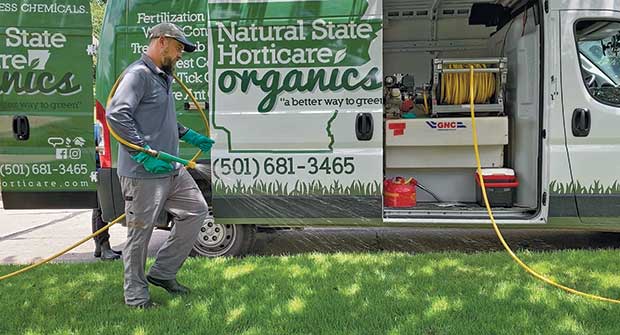
As lawn care operators (LCOs) finish out the unusual year that was 2020 and prepare for 2021, some are looking to examine how fertilizers can help them operate more efficiently and cost-effectively.
“The lawn care industry in general is continuing to still see growth,” says Tony Goldsby, director, professional turf products at The Andersons Plant Nutrient Group. “As far as fertilizers go, I think a lot of (lawn care operators) are looking for opportunities to continue to try and save money and also provide their clients with really high-quality turfgrasses.”
We spoke with Goldsby and Jeremy Bigler, channel manager at Lebanon Turf, about how enhanced-efficiency fertilizers could be the answer to helping LCOs achieve healthy turf while also helping them handle costs and labor shortages.
Improve fertilizer efficacy
Goldsby explains that “enhanced efficiency” is a broad definition that covers any fertilizer with a slow-release profile. The slow release can come from either putting a physical coating on the prill, like in polycoated urea, which has a plastic coating that slows down the release of that material, or stabilized nitrogen products. Stabilized nitrogen products are those where the fertilizer prill is combined with several inhibitor chemicals that prevent the loss of fertilizer material, both to the environment (a process known as volatilization) and into the soil profile.
“First and foremost, (enhanced-efficiency fertilizers) help a lot with just protecting that fertilizer investment from being lost to the environment,” Goldsby says. When it’s lost to the environment, it cannot be used by the turf. He then notes that when you add a urea product to turf without any inhibitors and the conditions are right, you can lose up to 40 percent of the nitrogen within a few days to the atmosphere through volatilization.
Less labor
Goldsby points out that the longevity of the enhanced-efficiency products slows down plant growth, which cuts down on the maintenance needed on a lawn.
“If the company is doing mowing and fertilizing, then they don’t have to mow as often,” he says. “Then, the other part to it is you can potentially get away with a lower (application) rate just because it’s spreading that feeding out over a longer period of time.”
These types of fertilizers, depending on the polymer coating, can feed the turf for six to eight weeks or longer in some cases, as opposed to seven to 14 days with a typical urea fertilizer. Goldsby estimates that LCOs are doing half to two-thirds of the amount of applications they typically would.
Though the enhanced-efficiency products often have a higher upfront cost, Goldsby says that you’re offsetting the cost increase by making sure that you’re keeping those nutrients in the soil, in a place where the turfgrass can actually use them.
Control growth
In addition to preventing nitrogen loss, which improves the fertilizer’s efficacy, the difference between enhanced-efficiency fertilizers and quickly available urea fertilizers is that the plant takes up the readily available urea immediately, which results in rapid growth, Goldsby says.
“The process is somewhat slowed down, or it’s a little bit smoother, when you’re putting down an enhanced-efficiency product, whether it’s a coated product or a stabilized product,” he explains. “That’s going to result in a longer feeding profile, and therefore, you’re not going to have to come back and do as many applications as you would with a quickly available course of nitrogen, like urea.”
Jeremy Bigler, channel manager at Lebanon Turf, adds that there could be an additional downside to traditional fertilizer applications: plant stress. He says that with controlled-release fertilizers, there’s less chance of stressing out the plant or burning the turf if you have a product with a high volume of controlled-release content.
Combination products
Bigler also recommends considering a formula that includes not only a controlled-release fertilizer, but also active ingredients, such as controlled-release fertilizer with herbicides, insecticides or both.
He explains there are additional products with multiple active ingredients, “For example, (use) preemergent and postemergent for that late spring application so that you’re preventing the crabgrass and taking care of those broadleaf weeds like dandelions at the same time.”
Compliance with state regulations
Both Bigler and Goldsby advise LCOs to keep an eye on application regulations that surround the turf and ornamental market.
“There are states like Maryland where they’ve mandated that you can’t use more than 1 pound of nitrogen application in a year, unless it comes from an enhanced-efficiency fertilizer source,” Goldsby says. “If you’re going to put out more than that, then it’s going to have to come from an enhanced-efficiency source.”


